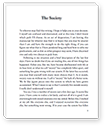Essay Instructions: Finance 501 application paper
Subject-Present value, Capital asset pricing model, Asset price Model
------------------------------------------------------------
All the instructions for the paper assignment is in the assignment itself. Minimum statistical data required. Just show the computation as requested in the instructions then write the paper. Any questions call me at . Thank you!
--------------------------------------- --------------------
Module 2 Case Background Material to help with the paper is on these websites.
1.http://www.prenhall.com/divisions/bp/app/cfldemo/TVM/PresentValue.html
2.http://www.public.asu.edu/~atmxh/fin361/ch2.pdf
3.http://www.studyfinance.com/lessons/timevalue/lesson08.html
--------------------------------------- --------------------
Module 2 Case assignment is below:
Part I:
Suppose you just inherited an oil well. This oil well is believed to have three years worth of oil left before it dries up. Here is how much income this oil well is projected to bring you each year for the next three years:
Year 1: $160,000; Year 2: $210,000; Year 3: $320,000
Compute the present value of this stream of income for a discount rate of 5%, 12%, and 17%. 1-2 Page paper.
Part II:
Read the following three sample business plans:Acme Consulting; Interstate Travel Center and Silvera and Sons
Which of these three projects do you think should have the highest discount rate? Which one do you think should have the lowest?
Turn in a Parts I and II in one Word document. For Part I make sure you show all your work. Part II should be in the form of a two page paper explaining your reasoning.
--------------------------------------- --------------------
Module 2 Session Long Project
One specialized type of security is called an equity future. This is a contract that guarantees you shares of a company to be delivered to you not today, but sometime in the future. What you would pay for such a contract depends on a) what price you expect the shares to be at in the future, and b) how volatile the stock is (i.e. what discount rate you should value this future payment of stocks).
Using the Yahoo Finance take a look at the five year chart for your reference company. Using this chart and other information you can find on this company,
write a one to two page paper answering the following question:
What would you pay for 100 shares of Walmart to be delivered to you in one years?
Use the concepts in the background materials to explain your answer.
---------------------------------------
Background Material to help with the paper is on these websites.
1.http://www.prenhall.com/divisions/bp/app/cfldemo/RR/RiskAndReturn.html
2.http://www.prenhall.com/divisions/bp/app/cfldemo/RR/CAPM.html
--------------------------------------- --------------------
Module 3 Case
CAPM vs. APT
The Capital Asset Pricing Model is not the only asset pricing model around. One of the competing approaches asset pricing is called the Arbitrage Pricing Theory, which was developed to address some of the criticisms of the CAPM.
Read the article below and do some of your own research using the CyberLibrary and Internet search engines.
--------------------------------------
Then write a 4 page paper answering the following question:
Do you think APT or the CAPM is the best approach for a financial professional to use?
Defend your answer rigorously. And don't cop out by saying "I like both approaches", take a side and defend it.
--------------------------------------
This an abstract paper to further help with the paper!
Risk and Return
The Economist; London; Feb 2, 1991; Anonymous;
Abstract:
The capital asset pricing model (CAPM) states that the return on a stock depends on whether the stock's price follows prices in the market as a whole. The more closely a stock follows the market, the greater will be its expected return.
A technique called mean-variance analysis can be used to construct a series of portfolios that are efficient. Instead of looking at the covariances among stocks in a portfolio, the CAPM divides a stock's risk into 2 parts: systematic and unsystematic. The CAPM assumes that no investor has better information than another and that, if a stock's beta is known, its long-run return can be predicted. Researchers found that the CAPM works only in the long run. Despite doubts, the CAPS passed most of its early tests. The arbitrage pricing theory (APT) divides systematic risk into smaller component risks. Recent research has suggested that the 4-factor version of the APT is better at predicting the return on a stock than the simplest version of the CAPM. In some of its basic ideas, but not in its details, the APT builds on rather than replaces the CAPM
------------------------------------------------------------
Module 3
Session Long Project
Using the PC Quote Web Page find the value of beta for Walmart.
Write a two page paper discussing the following items:
a. What does this beta means in terms of your choice of including this company in your overall portfolio?
b. What two other companies would you pick along with your reference company if you are using beta as a criteria? The other two companies that are selected using beta as a criteria is Kmart and Target.
Explain your answers thoroughly.
------------------------------------------------------------
This is Module 4.
Background Materials to help with paper assignment is below.
The Capital Budgeting Process is a highly comprehensive overview that is especially useful for the problem set.
StudyFinance.com has an excellent Summary of Capital Budgeting
Corporate Finance Live has a good Section on Capital Budgeting.
Finally, this Meta-Site on Capital Budgeting from Harcourt College Publishers has many more links to sites that are highly relevant to this module
-----------------------------------------------------------
This is Module 4 Case assignment for the paper below.
-----------------------------------------------------------
CU Boxes Inc.
CU Boxes Inc. makes boxes for shoe manufacturers. One of the machines that CU uses may need replacement.
The following information is available to you:
Revenues will not change if the machine is replaced.
Both the present machine and the new machine will last 5 years and will have no disposal value in five years.
The new machine will cost $400,000. The old machine can be disposed of right now for a disposal value of $10,000.
The new machine will reduce operating costs by $100,000 per year (assume cash flows at the end of the years.)
Assume a required rate of return or discount rate of 9%
Part 1: Determine if the new machine should be purchased. Use NPV, IRR, and Payback in your analysis where appropriate. Refer to the articles below and the background materials in your analysis.
Part 2: Read the articles below and discuss what method (NPV or others) is the best method to use for capital budgeting purposes. Defend your arguments carefully.
Answer Part 1 and Part 2 for a total of four pages.
----------------------------------------------------------
Additional info an an example of how the paper should look is below.
Read these articles below (click on the titles):
Modified internal rate of return: Will it replace IRR?
Lefley, Frank. Management Accounting. London: Jan 1997. Vol. 75, Iss. 1; pg. 64, 2 pgs
Abstract (Article Summary)
The 2 main discounted cash flow methods are the net present value and the internal rate of return (IRR). Although IRR suffers from a number of defects, it continues to be the most popular method used in industry. Recently a modified internal rate of return (MIRR) method was developed to address some of the defects of IRR. The MIRR addresses some of the deficiencies of conventional IRR, such as: 1. It eliminates multiple IRR rates. 2. It addresses the reinvestment rate issue and reduces over-optimism. 3. It produces a result which, when ranking projects, is consistent with the NPV rule.
Capital budgeting needs vision
Business line. Islamabad: Jul 21, 2003. pg. 1
Abstract (Article Summary)
"WHAT business are you in?" a CEO of Ponds was once asked. "We sell hope," he said. (A wide definition of business indeed.) The same question was posed to Akio Morita, the founder of Sony. He said, "We are in entertainment." And when a truck-fleet owner was asked the same question, he said, "We are into truck and transportation business." (A very narrow definition of business.)
These decisions have to fulfil the criteria of creating net positive present value for the organisation. Thus an organisation should grab and hold on to every opportunity (both external and internal) that creates positive net present value (NPV) for its shareholders. And in a competitive environment, every organisation has to attract, reward and retain its shareholders and potential investors.
Long-term investment decisions are called capital budgeting/ capital expenditure decisions - launching a new product, improvisation, modernisation, expansion, replacement of fixed assets, research and development, purchasing new fixed assets, acquisition, takeover, merger, alliances, and so on.
There are faxes for this order.


